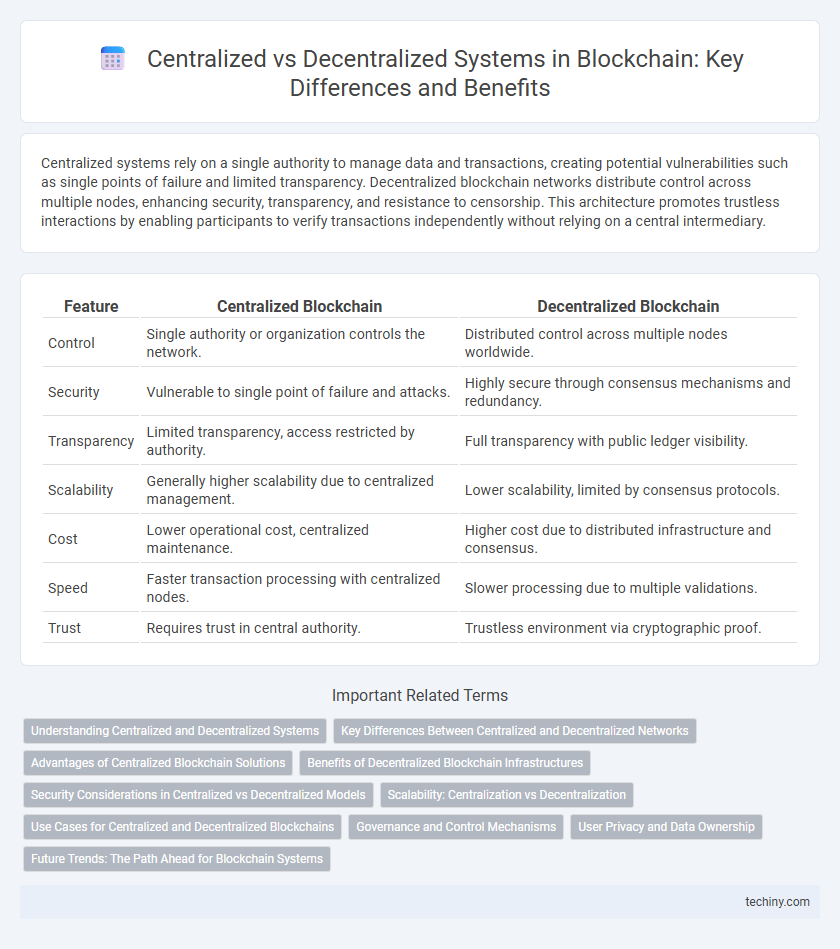Centralized systems rely on a single authority to manage data and transactions, creating potential vulnerabilities such as single points of failure and limited transparency. Decentralized blockchain networks distribute control across multiple nodes, enhancing security, transparency, and resistance to censorship. This architecture promotes trustless interactions by enabling participants to verify transactions independently without relying on a central intermediary.
Table of Comparison
| Feature | Centralized Blockchain | Decentralized Blockchain |
|---|---|---|
| Control | Single authority or organization controls the network. | Distributed control across multiple nodes worldwide. |
| Security | Vulnerable to single point of failure and attacks. | Highly secure through consensus mechanisms and redundancy. |
| Transparency | Limited transparency, access restricted by authority. | Full transparency with public ledger visibility. |
| Scalability | Generally higher scalability due to centralized management. | Lower scalability, limited by consensus protocols. |
| Cost | Lower operational cost, centralized maintenance. | Higher cost due to distributed infrastructure and consensus. |
| Speed | Faster transaction processing with centralized nodes. | Slower processing due to multiple validations. |
| Trust | Requires trust in central authority. | Trustless environment via cryptographic proof. |
Understanding Centralized and Decentralized Systems
Centralized systems consolidate control and decision-making within a single authority, enhancing efficiency but increasing vulnerability to single points of failure and censorship. Decentralized systems distribute control across multiple nodes, promoting transparency, security, and resilience against attacks or failures. Blockchain technology exemplifies decentralized architecture by enabling trustless transactions without intermediaries, fundamentally shifting data management paradigms.
Key Differences Between Centralized and Decentralized Networks
Centralized networks rely on a single authority to control data and decision-making, leading to faster processing but increased vulnerability to attacks and censorship. Decentralized networks distribute control among multiple nodes, enhancing security, transparency, and resistance to single points of failure while potentially introducing latency and scalability challenges. The key differences revolve around control distribution, fault tolerance, and trust models, impacting system robustness and user autonomy.
Advantages of Centralized Blockchain Solutions
Centralized blockchain solutions offer enhanced transaction speed and scalability due to controlled network access and a limited number of validating nodes. They provide simplified governance and regulatory compliance by concentrating authority within a single organization or consortium. Centralized systems often enable more efficient dispute resolution and maintenance, resulting in lower operational costs compared to fully decentralized networks.
Benefits of Decentralized Blockchain Infrastructures
Decentralized blockchain infrastructures enhance security by distributing data across multiple nodes, reducing the risk of single points of failure and cyber attacks. They promote transparency and trust through immutable ledgers accessible to all participants, fostering greater accountability. Increased resilience and censorship resistance enable uninterrupted operations even during network disruptions or external pressures.
Security Considerations in Centralized vs Decentralized Models
Centralized blockchain systems concentrate data control within a single authority, making them susceptible to single points of failure and targeted cyberattacks, which can compromise the entire network's security. Decentralized models distribute data and transaction validation across multiple nodes, enhancing resilience against breaches and reducing the risk of data manipulation due to the consensus mechanisms employed. However, decentralized networks may face challenges like slower transaction processing and complexities in governance, which require robust cryptographic protocols to maintain security integrity.
Scalability: Centralization vs Decentralization
Centralized blockchain systems often achieve higher scalability due to controlled network architecture and fewer nodes, enabling faster transaction processing and reduced latency. Decentralized blockchains prioritize security and trustlessness by distributing consensus across numerous nodes, which can limit scalability because of increased communication overhead and slower transaction finality. Layer 2 solutions and sharding are frequently employed to enhance scalability in decentralized networks without compromising their core principles.
Use Cases for Centralized and Decentralized Blockchains
Centralized blockchains are ideal for industries requiring high transaction throughput and controlled access, such as banking, supply chain management, and healthcare record systems, where data privacy and regulatory compliance are paramount. Decentralized blockchains excel in applications demanding transparency, immutability, and trustlessness, including cryptocurrency platforms like Bitcoin and Ethereum, decentralized finance (DeFi) services, and decentralized autonomous organizations (DAOs). The choice between centralized and decentralized blockchain depends on use case priorities, balancing security, scalability, and governance requirements.
Governance and Control Mechanisms
Centralized blockchain governance relies on a single authority or a limited group of entities to make decisions, allowing for faster consensus but creating potential single points of failure and censorship risks. Decentralized governance distributes decision-making power across a broad network of participants through consensus algorithms like Proof of Work or Proof of Stake, enhancing transparency and resistance to manipulation. Control mechanisms in decentralized systems include on-chain voting, stakeholder consensus, and smart contract enforcement, which collectively ensure protocol updates and improvements are community-driven.
User Privacy and Data Ownership
Centralized blockchain systems often require users to trust a single authority with their data, increasing the risk of privacy breaches and limited data ownership. Decentralized blockchains distribute control across multiple nodes, enhancing user privacy by reducing single points of failure and enabling true data ownership through cryptographic keys. This architecture empowers users to manage their data securely without reliance on centralized intermediaries.
Future Trends: The Path Ahead for Blockchain Systems
Future trends in blockchain systems emphasize a gradual shift from centralized models to decentralized architectures to enhance security, transparency, and trust. Innovations like decentralized finance (DeFi), scalable consensus algorithms, and interoperable blockchain networks are driving this evolution. The increasing adoption of decentralized autonomous organizations (DAOs) demonstrates a clear trajectory toward more distributed governance and decision-making frameworks in blockchain ecosystems.
Centralized vs Decentralized Infographic

 techiny.com
techiny.com